Health and Safety in Healthcare
VerifiedAdded on 2020/02/05
|12
|3338
|42
AI Summary
This assignment delves into the critical topic of health and safety within healthcare settings. It examines relevant legislation, outlines best practices for ensuring a secure environment, and emphasizes the role of professionals like nurses and social workers in upholding these standards. The document also highlights the psychological impact of workplace stress on healthcare providers and discusses strategies for mitigating it.
Contribute Materials
Your contribution can guide someone’s learning journey. Share your
documents today.
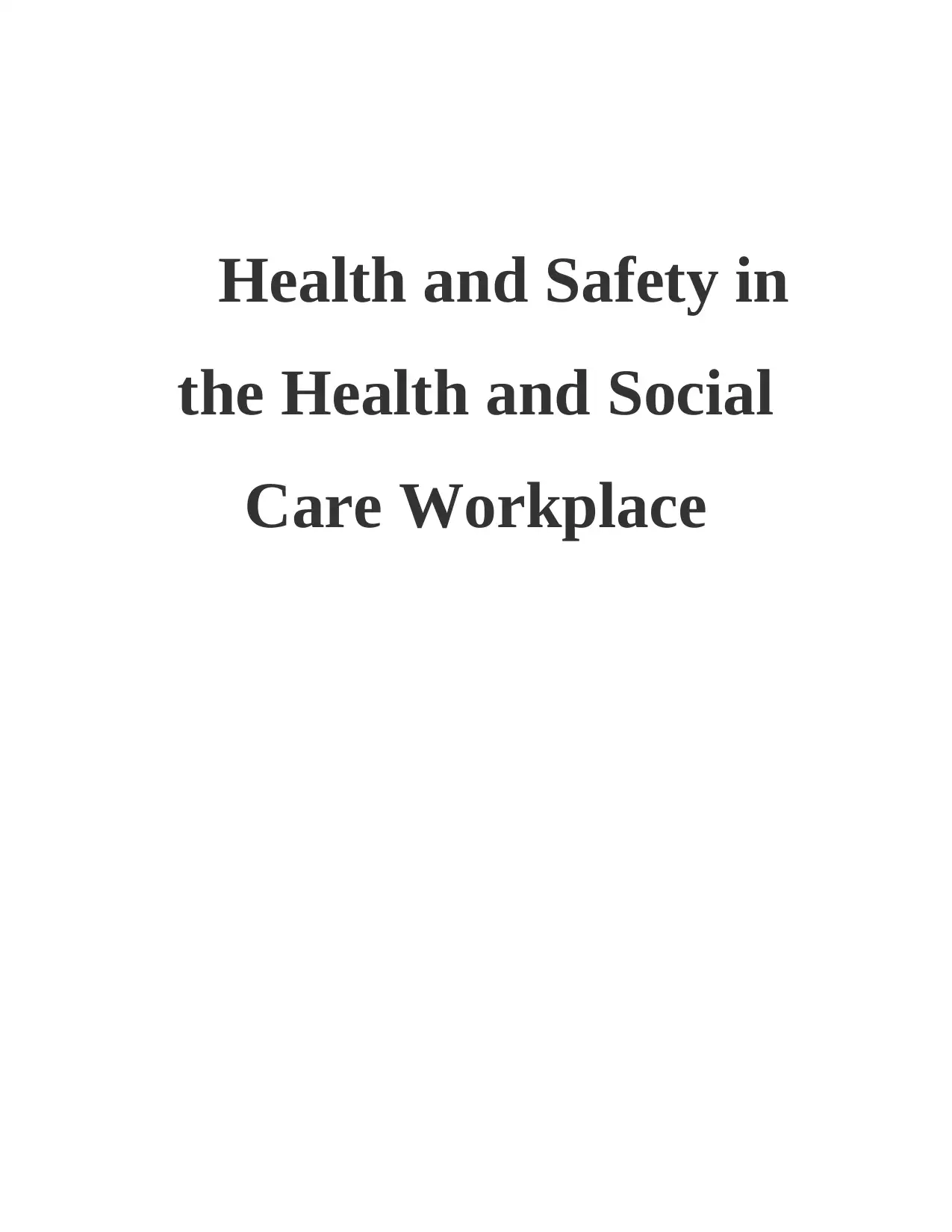
Health and Safety in
the Health and Social
Care Workplace
the Health and Social
Care Workplace
Secure Best Marks with AI Grader
Need help grading? Try our AI Grader for instant feedback on your assignments.
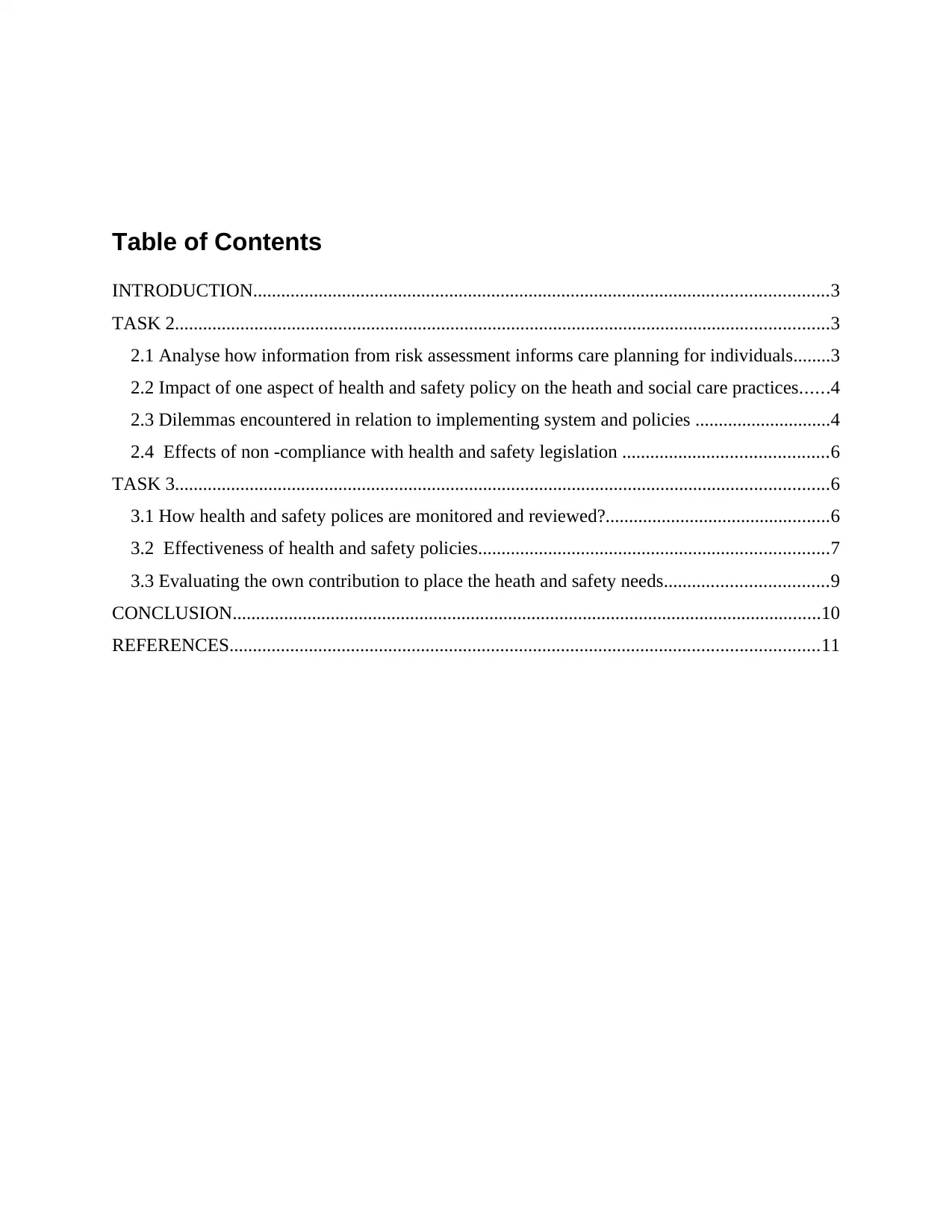
Table of Contents
INTRODUCTION...........................................................................................................................3
TASK 2............................................................................................................................................3
2.1 Analyse how information from risk assessment informs care planning for individuals........3
2.2 Impact of one aspect of health and safety policy on the heath and social care practices......4
2.3 Dilemmas encountered in relation to implementing system and policies .............................4
2.4 Effects of non -compliance with health and safety legislation ............................................6
TASK 3............................................................................................................................................6
3.1 How health and safety polices are monitored and reviewed?................................................6
3.2 Effectiveness of health and safety policies...........................................................................7
3.3 Evaluating the own contribution to place the heath and safety needs...................................9
CONCLUSION..............................................................................................................................10
REFERENCES..............................................................................................................................11
INTRODUCTION...........................................................................................................................3
TASK 2............................................................................................................................................3
2.1 Analyse how information from risk assessment informs care planning for individuals........3
2.2 Impact of one aspect of health and safety policy on the heath and social care practices......4
2.3 Dilemmas encountered in relation to implementing system and policies .............................4
2.4 Effects of non -compliance with health and safety legislation ............................................6
TASK 3............................................................................................................................................6
3.1 How health and safety polices are monitored and reviewed?................................................6
3.2 Effectiveness of health and safety policies...........................................................................7
3.3 Evaluating the own contribution to place the heath and safety needs...................................9
CONCLUSION..............................................................................................................................10
REFERENCES..............................................................................................................................11
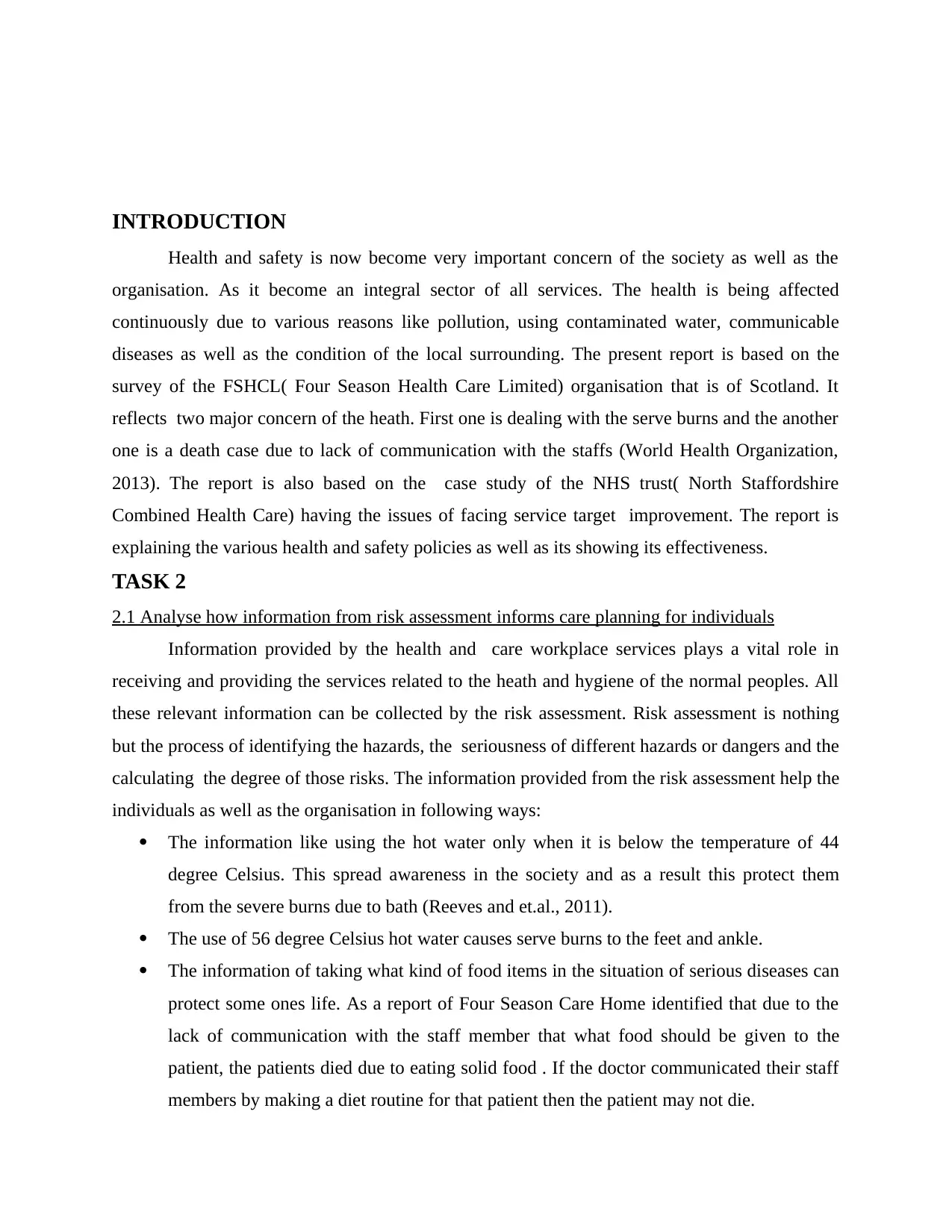
INTRODUCTION
Health and safety is now become very important concern of the society as well as the
organisation. As it become an integral sector of all services. The health is being affected
continuously due to various reasons like pollution, using contaminated water, communicable
diseases as well as the condition of the local surrounding. The present report is based on the
survey of the FSHCL( Four Season Health Care Limited) organisation that is of Scotland. It
reflects two major concern of the heath. First one is dealing with the serve burns and the another
one is a death case due to lack of communication with the staffs (World Health Organization,
2013). The report is also based on the case study of the NHS trust( North Staffordshire
Combined Health Care) having the issues of facing service target improvement. The report is
explaining the various health and safety policies as well as its showing its effectiveness.
TASK 2
2.1 Analyse how information from risk assessment informs care planning for individuals
Information provided by the health and care workplace services plays a vital role in
receiving and providing the services related to the heath and hygiene of the normal peoples. All
these relevant information can be collected by the risk assessment. Risk assessment is nothing
but the process of identifying the hazards, the seriousness of different hazards or dangers and the
calculating the degree of those risks. The information provided from the risk assessment help the
individuals as well as the organisation in following ways:
The information like using the hot water only when it is below the temperature of 44
degree Celsius. This spread awareness in the society and as a result this protect them
from the severe burns due to bath (Reeves and et.al., 2011).
The use of 56 degree Celsius hot water causes serve burns to the feet and ankle.
The information of taking what kind of food items in the situation of serious diseases can
protect some ones life. As a report of Four Season Care Home identified that due to the
lack of communication with the staff member that what food should be given to the
patient, the patients died due to eating solid food . If the doctor communicated their staff
members by making a diet routine for that patient then the patient may not die.
Health and safety is now become very important concern of the society as well as the
organisation. As it become an integral sector of all services. The health is being affected
continuously due to various reasons like pollution, using contaminated water, communicable
diseases as well as the condition of the local surrounding. The present report is based on the
survey of the FSHCL( Four Season Health Care Limited) organisation that is of Scotland. It
reflects two major concern of the heath. First one is dealing with the serve burns and the another
one is a death case due to lack of communication with the staffs (World Health Organization,
2013). The report is also based on the case study of the NHS trust( North Staffordshire
Combined Health Care) having the issues of facing service target improvement. The report is
explaining the various health and safety policies as well as its showing its effectiveness.
TASK 2
2.1 Analyse how information from risk assessment informs care planning for individuals
Information provided by the health and care workplace services plays a vital role in
receiving and providing the services related to the heath and hygiene of the normal peoples. All
these relevant information can be collected by the risk assessment. Risk assessment is nothing
but the process of identifying the hazards, the seriousness of different hazards or dangers and the
calculating the degree of those risks. The information provided from the risk assessment help the
individuals as well as the organisation in following ways:
The information like using the hot water only when it is below the temperature of 44
degree Celsius. This spread awareness in the society and as a result this protect them
from the severe burns due to bath (Reeves and et.al., 2011).
The use of 56 degree Celsius hot water causes serve burns to the feet and ankle.
The information of taking what kind of food items in the situation of serious diseases can
protect some ones life. As a report of Four Season Care Home identified that due to the
lack of communication with the staff member that what food should be given to the
patient, the patients died due to eating solid food . If the doctor communicated their staff
members by making a diet routine for that patient then the patient may not die.
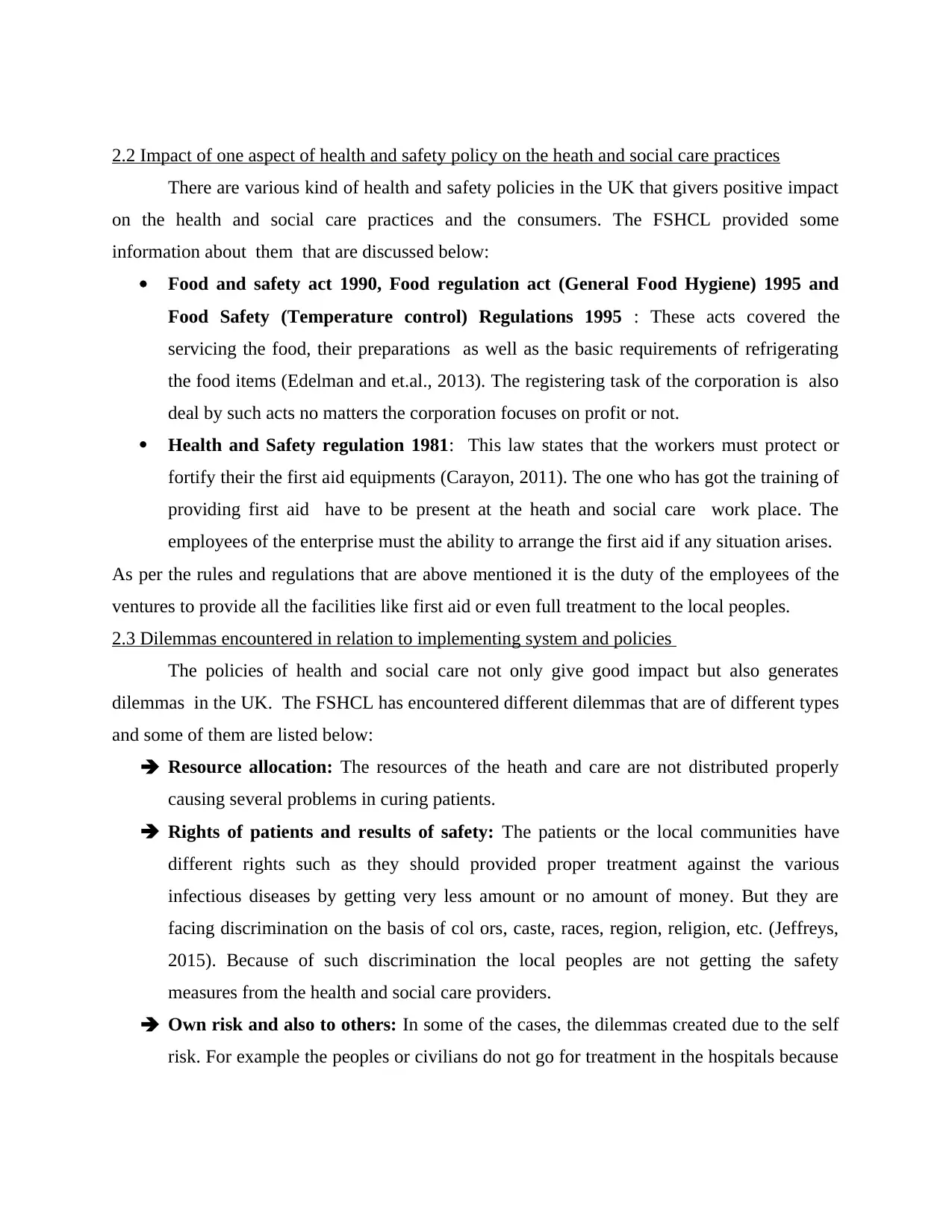
2.2 Impact of one aspect of health and safety policy on the heath and social care practices
There are various kind of health and safety policies in the UK that givers positive impact
on the health and social care practices and the consumers. The FSHCL provided some
information about them that are discussed below:
Food and safety act 1990, Food regulation act (General Food Hygiene) 1995 and
Food Safety (Temperature control) Regulations 1995 : These acts covered the
servicing the food, their preparations as well as the basic requirements of refrigerating
the food items (Edelman and et.al., 2013). The registering task of the corporation is also
deal by such acts no matters the corporation focuses on profit or not.
Health and Safety regulation 1981: This law states that the workers must protect or
fortify their the first aid equipments (Carayon, 2011). The one who has got the training of
providing first aid have to be present at the heath and social care work place. The
employees of the enterprise must the ability to arrange the first aid if any situation arises.
As per the rules and regulations that are above mentioned it is the duty of the employees of the
ventures to provide all the facilities like first aid or even full treatment to the local peoples.
2.3 Dilemmas encountered in relation to implementing system and policies
The policies of health and social care not only give good impact but also generates
dilemmas in the UK. The FSHCL has encountered different dilemmas that are of different types
and some of them are listed below:
Resource allocation: The resources of the heath and care are not distributed properly
causing several problems in curing patients.
Rights of patients and results of safety: The patients or the local communities have
different rights such as they should provided proper treatment against the various
infectious diseases by getting very less amount or no amount of money. But they are
facing discrimination on the basis of col ors, caste, races, region, religion, etc. (Jeffreys,
2015). Because of such discrimination the local peoples are not getting the safety
measures from the health and social care providers.
Own risk and also to others: In some of the cases, the dilemmas created due to the self
risk. For example the peoples or civilians do not go for treatment in the hospitals because
There are various kind of health and safety policies in the UK that givers positive impact
on the health and social care practices and the consumers. The FSHCL provided some
information about them that are discussed below:
Food and safety act 1990, Food regulation act (General Food Hygiene) 1995 and
Food Safety (Temperature control) Regulations 1995 : These acts covered the
servicing the food, their preparations as well as the basic requirements of refrigerating
the food items (Edelman and et.al., 2013). The registering task of the corporation is also
deal by such acts no matters the corporation focuses on profit or not.
Health and Safety regulation 1981: This law states that the workers must protect or
fortify their the first aid equipments (Carayon, 2011). The one who has got the training of
providing first aid have to be present at the heath and social care work place. The
employees of the enterprise must the ability to arrange the first aid if any situation arises.
As per the rules and regulations that are above mentioned it is the duty of the employees of the
ventures to provide all the facilities like first aid or even full treatment to the local peoples.
2.3 Dilemmas encountered in relation to implementing system and policies
The policies of health and social care not only give good impact but also generates
dilemmas in the UK. The FSHCL has encountered different dilemmas that are of different types
and some of them are listed below:
Resource allocation: The resources of the heath and care are not distributed properly
causing several problems in curing patients.
Rights of patients and results of safety: The patients or the local communities have
different rights such as they should provided proper treatment against the various
infectious diseases by getting very less amount or no amount of money. But they are
facing discrimination on the basis of col ors, caste, races, region, religion, etc. (Jeffreys,
2015). Because of such discrimination the local peoples are not getting the safety
measures from the health and social care providers.
Own risk and also to others: In some of the cases, the dilemmas created due to the self
risk. For example the peoples or civilians do not go for treatment in the hospitals because
Secure Best Marks with AI Grader
Need help grading? Try our AI Grader for instant feedback on your assignments.
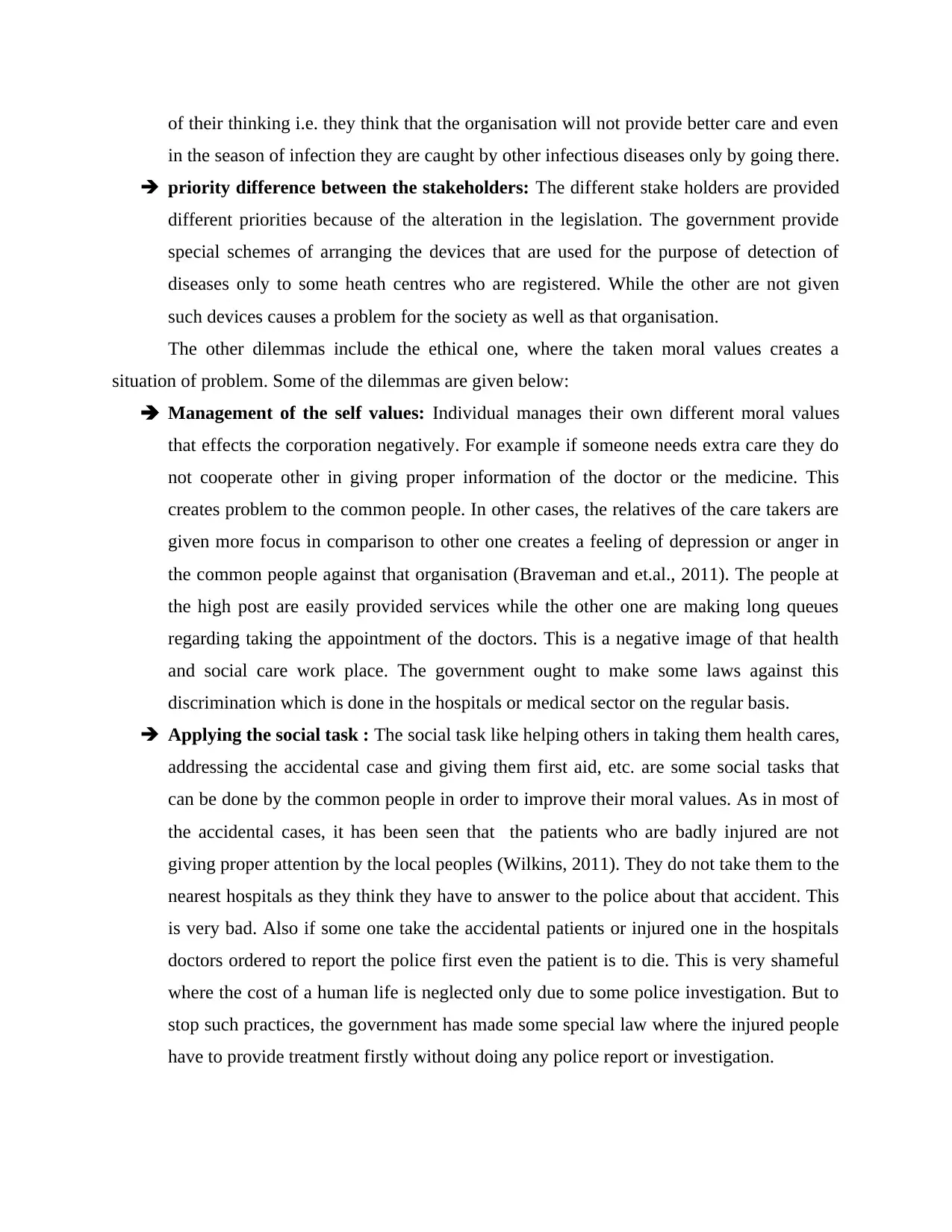
of their thinking i.e. they think that the organisation will not provide better care and even
in the season of infection they are caught by other infectious diseases only by going there.
priority difference between the stakeholders: The different stake holders are provided
different priorities because of the alteration in the legislation. The government provide
special schemes of arranging the devices that are used for the purpose of detection of
diseases only to some heath centres who are registered. While the other are not given
such devices causes a problem for the society as well as that organisation.
The other dilemmas include the ethical one, where the taken moral values creates a
situation of problem. Some of the dilemmas are given below:
Management of the self values: Individual manages their own different moral values
that effects the corporation negatively. For example if someone needs extra care they do
not cooperate other in giving proper information of the doctor or the medicine. This
creates problem to the common people. In other cases, the relatives of the care takers are
given more focus in comparison to other one creates a feeling of depression or anger in
the common people against that organisation (Braveman and et.al., 2011). The people at
the high post are easily provided services while the other one are making long queues
regarding taking the appointment of the doctors. This is a negative image of that health
and social care work place. The government ought to make some laws against this
discrimination which is done in the hospitals or medical sector on the regular basis.
Applying the social task : The social task like helping others in taking them health cares,
addressing the accidental case and giving them first aid, etc. are some social tasks that
can be done by the common people in order to improve their moral values. As in most of
the accidental cases, it has been seen that the patients who are badly injured are not
giving proper attention by the local peoples (Wilkins, 2011). They do not take them to the
nearest hospitals as they think they have to answer to the police about that accident. This
is very bad. Also if some one take the accidental patients or injured one in the hospitals
doctors ordered to report the police first even the patient is to die. This is very shameful
where the cost of a human life is neglected only due to some police investigation. But to
stop such practices, the government has made some special law where the injured people
have to provide treatment firstly without doing any police report or investigation.
in the season of infection they are caught by other infectious diseases only by going there.
priority difference between the stakeholders: The different stake holders are provided
different priorities because of the alteration in the legislation. The government provide
special schemes of arranging the devices that are used for the purpose of detection of
diseases only to some heath centres who are registered. While the other are not given
such devices causes a problem for the society as well as that organisation.
The other dilemmas include the ethical one, where the taken moral values creates a
situation of problem. Some of the dilemmas are given below:
Management of the self values: Individual manages their own different moral values
that effects the corporation negatively. For example if someone needs extra care they do
not cooperate other in giving proper information of the doctor or the medicine. This
creates problem to the common people. In other cases, the relatives of the care takers are
given more focus in comparison to other one creates a feeling of depression or anger in
the common people against that organisation (Braveman and et.al., 2011). The people at
the high post are easily provided services while the other one are making long queues
regarding taking the appointment of the doctors. This is a negative image of that health
and social care work place. The government ought to make some laws against this
discrimination which is done in the hospitals or medical sector on the regular basis.
Applying the social task : The social task like helping others in taking them health cares,
addressing the accidental case and giving them first aid, etc. are some social tasks that
can be done by the common people in order to improve their moral values. As in most of
the accidental cases, it has been seen that the patients who are badly injured are not
giving proper attention by the local peoples (Wilkins, 2011). They do not take them to the
nearest hospitals as they think they have to answer to the police about that accident. This
is very bad. Also if some one take the accidental patients or injured one in the hospitals
doctors ordered to report the police first even the patient is to die. This is very shameful
where the cost of a human life is neglected only due to some police investigation. But to
stop such practices, the government has made some special law where the injured people
have to provide treatment firstly without doing any police report or investigation.
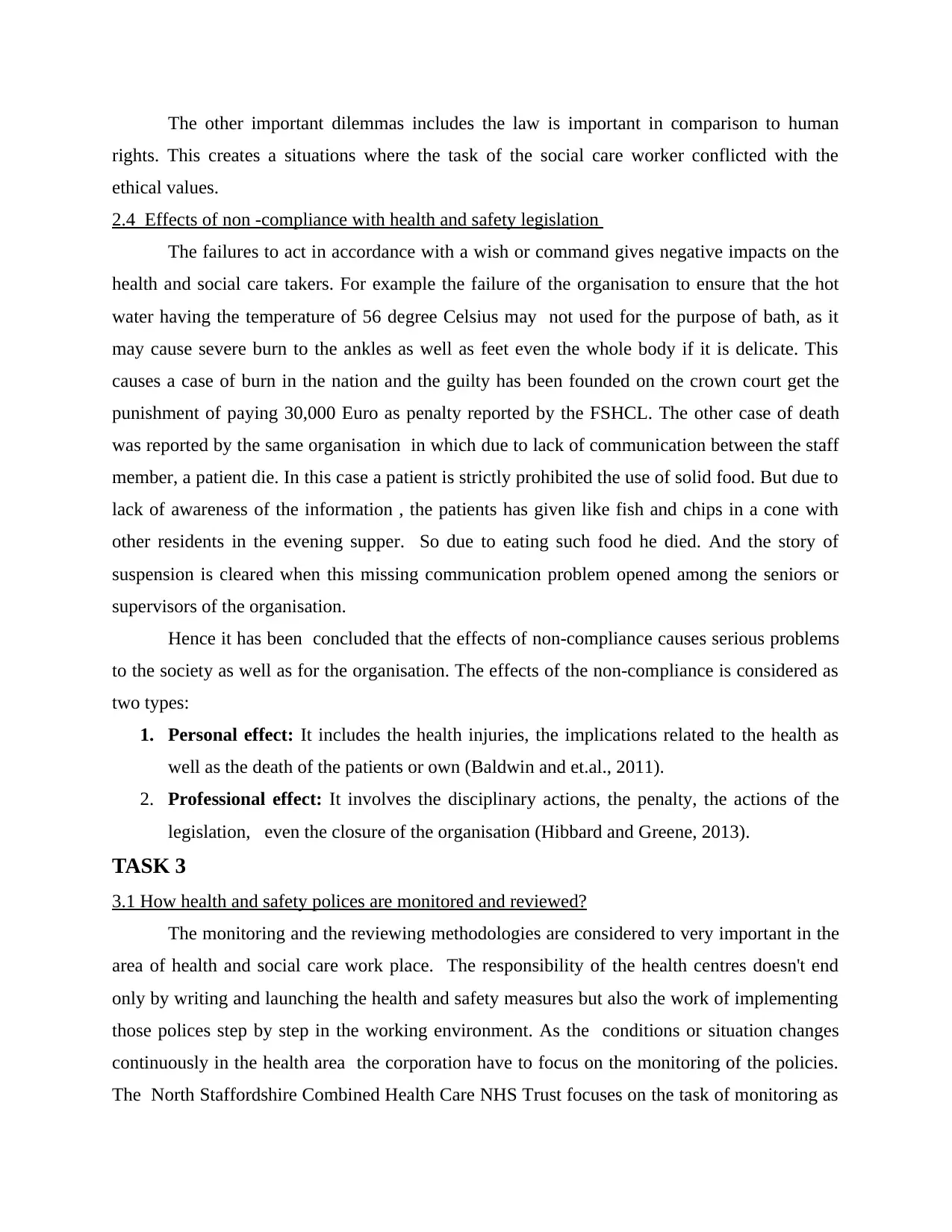
The other important dilemmas includes the law is important in comparison to human
rights. This creates a situations where the task of the social care worker conflicted with the
ethical values.
2.4 Effects of non -compliance with health and safety legislation
The failures to act in accordance with a wish or command gives negative impacts on the
health and social care takers. For example the failure of the organisation to ensure that the hot
water having the temperature of 56 degree Celsius may not used for the purpose of bath, as it
may cause severe burn to the ankles as well as feet even the whole body if it is delicate. This
causes a case of burn in the nation and the guilty has been founded on the crown court get the
punishment of paying 30,000 Euro as penalty reported by the FSHCL. The other case of death
was reported by the same organisation in which due to lack of communication between the staff
member, a patient die. In this case a patient is strictly prohibited the use of solid food. But due to
lack of awareness of the information , the patients has given like fish and chips in a cone with
other residents in the evening supper. So due to eating such food he died. And the story of
suspension is cleared when this missing communication problem opened among the seniors or
supervisors of the organisation.
Hence it has been concluded that the effects of non-compliance causes serious problems
to the society as well as for the organisation. The effects of the non-compliance is considered as
two types:
1. Personal effect: It includes the health injuries, the implications related to the health as
well as the death of the patients or own (Baldwin and et.al., 2011).
2. Professional effect: It involves the disciplinary actions, the penalty, the actions of the
legislation, even the closure of the organisation (Hibbard and Greene, 2013).
TASK 3
3.1 How health and safety polices are monitored and reviewed?
The monitoring and the reviewing methodologies are considered to very important in the
area of health and social care work place. The responsibility of the health centres doesn't end
only by writing and launching the health and safety measures but also the work of implementing
those polices step by step in the working environment. As the conditions or situation changes
continuously in the health area the corporation have to focus on the monitoring of the policies.
The North Staffordshire Combined Health Care NHS Trust focuses on the task of monitoring as
rights. This creates a situations where the task of the social care worker conflicted with the
ethical values.
2.4 Effects of non -compliance with health and safety legislation
The failures to act in accordance with a wish or command gives negative impacts on the
health and social care takers. For example the failure of the organisation to ensure that the hot
water having the temperature of 56 degree Celsius may not used for the purpose of bath, as it
may cause severe burn to the ankles as well as feet even the whole body if it is delicate. This
causes a case of burn in the nation and the guilty has been founded on the crown court get the
punishment of paying 30,000 Euro as penalty reported by the FSHCL. The other case of death
was reported by the same organisation in which due to lack of communication between the staff
member, a patient die. In this case a patient is strictly prohibited the use of solid food. But due to
lack of awareness of the information , the patients has given like fish and chips in a cone with
other residents in the evening supper. So due to eating such food he died. And the story of
suspension is cleared when this missing communication problem opened among the seniors or
supervisors of the organisation.
Hence it has been concluded that the effects of non-compliance causes serious problems
to the society as well as for the organisation. The effects of the non-compliance is considered as
two types:
1. Personal effect: It includes the health injuries, the implications related to the health as
well as the death of the patients or own (Baldwin and et.al., 2011).
2. Professional effect: It involves the disciplinary actions, the penalty, the actions of the
legislation, even the closure of the organisation (Hibbard and Greene, 2013).
TASK 3
3.1 How health and safety polices are monitored and reviewed?
The monitoring and the reviewing methodologies are considered to very important in the
area of health and social care work place. The responsibility of the health centres doesn't end
only by writing and launching the health and safety measures but also the work of implementing
those polices step by step in the working environment. As the conditions or situation changes
continuously in the health area the corporation have to focus on the monitoring of the policies.
The North Staffordshire Combined Health Care NHS Trust focuses on the task of monitoring as
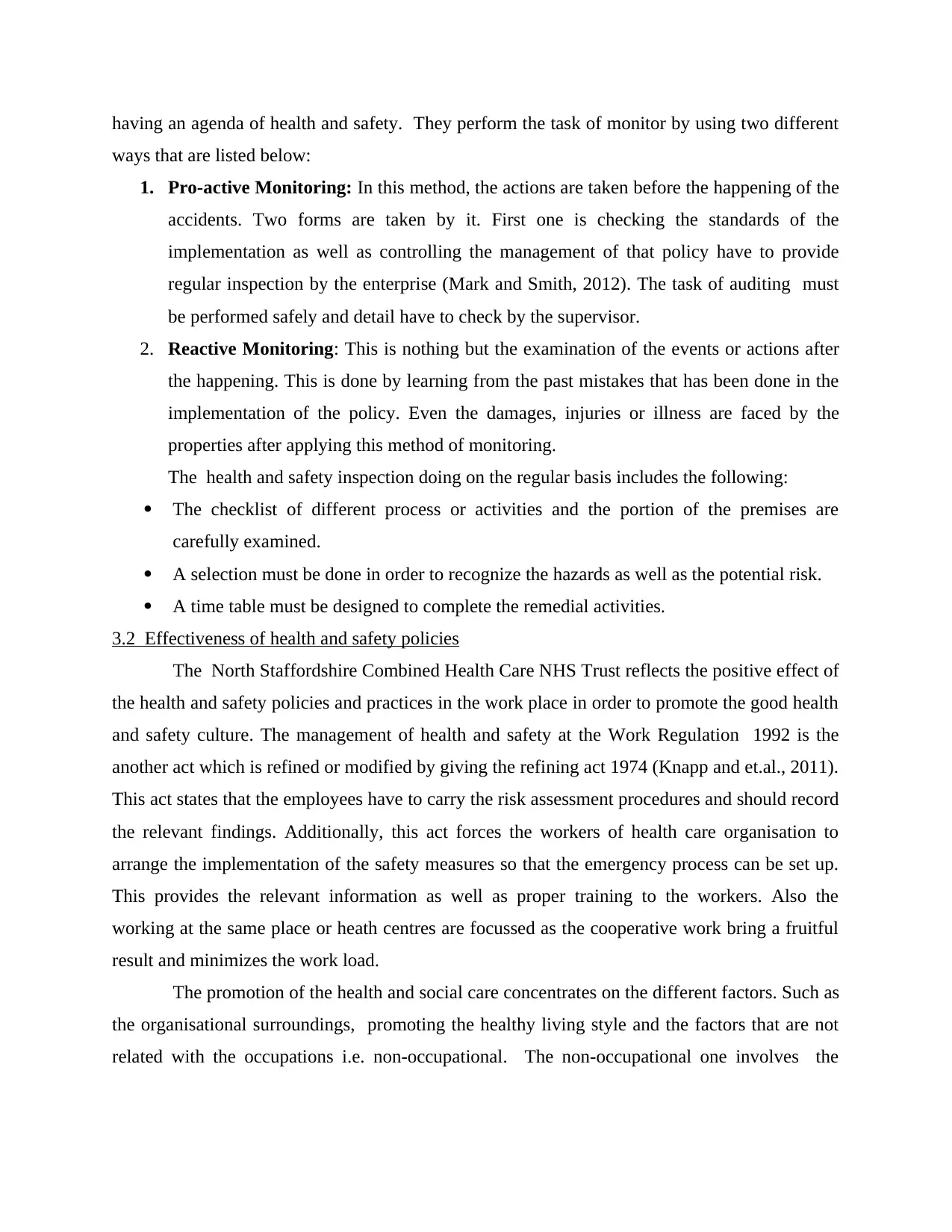
having an agenda of health and safety. They perform the task of monitor by using two different
ways that are listed below:
1. Pro-active Monitoring: In this method, the actions are taken before the happening of the
accidents. Two forms are taken by it. First one is checking the standards of the
implementation as well as controlling the management of that policy have to provide
regular inspection by the enterprise (Mark and Smith, 2012). The task of auditing must
be performed safely and detail have to check by the supervisor.
2. Reactive Monitoring: This is nothing but the examination of the events or actions after
the happening. This is done by learning from the past mistakes that has been done in the
implementation of the policy. Even the damages, injuries or illness are faced by the
properties after applying this method of monitoring.
The health and safety inspection doing on the regular basis includes the following:
The checklist of different process or activities and the portion of the premises are
carefully examined.
A selection must be done in order to recognize the hazards as well as the potential risk.
A time table must be designed to complete the remedial activities.
3.2 Effectiveness of health and safety policies
The North Staffordshire Combined Health Care NHS Trust reflects the positive effect of
the health and safety policies and practices in the work place in order to promote the good health
and safety culture. The management of health and safety at the Work Regulation 1992 is the
another act which is refined or modified by giving the refining act 1974 (Knapp and et.al., 2011).
This act states that the employees have to carry the risk assessment procedures and should record
the relevant findings. Additionally, this act forces the workers of health care organisation to
arrange the implementation of the safety measures so that the emergency process can be set up.
This provides the relevant information as well as proper training to the workers. Also the
working at the same place or heath centres are focussed as the cooperative work bring a fruitful
result and minimizes the work load.
The promotion of the health and social care concentrates on the different factors. Such as
the organisational surroundings, promoting the healthy living style and the factors that are not
related with the occupations i.e. non-occupational. The non-occupational one involves the
ways that are listed below:
1. Pro-active Monitoring: In this method, the actions are taken before the happening of the
accidents. Two forms are taken by it. First one is checking the standards of the
implementation as well as controlling the management of that policy have to provide
regular inspection by the enterprise (Mark and Smith, 2012). The task of auditing must
be performed safely and detail have to check by the supervisor.
2. Reactive Monitoring: This is nothing but the examination of the events or actions after
the happening. This is done by learning from the past mistakes that has been done in the
implementation of the policy. Even the damages, injuries or illness are faced by the
properties after applying this method of monitoring.
The health and safety inspection doing on the regular basis includes the following:
The checklist of different process or activities and the portion of the premises are
carefully examined.
A selection must be done in order to recognize the hazards as well as the potential risk.
A time table must be designed to complete the remedial activities.
3.2 Effectiveness of health and safety policies
The North Staffordshire Combined Health Care NHS Trust reflects the positive effect of
the health and safety policies and practices in the work place in order to promote the good health
and safety culture. The management of health and safety at the Work Regulation 1992 is the
another act which is refined or modified by giving the refining act 1974 (Knapp and et.al., 2011).
This act states that the employees have to carry the risk assessment procedures and should record
the relevant findings. Additionally, this act forces the workers of health care organisation to
arrange the implementation of the safety measures so that the emergency process can be set up.
This provides the relevant information as well as proper training to the workers. Also the
working at the same place or heath centres are focussed as the cooperative work bring a fruitful
result and minimizes the work load.
The promotion of the health and social care concentrates on the different factors. Such as
the organisational surroundings, promoting the healthy living style and the factors that are not
related with the occupations i.e. non-occupational. The non-occupational one involves the
Paraphrase This Document
Need a fresh take? Get an instant paraphrase of this document with our AI Paraphraser
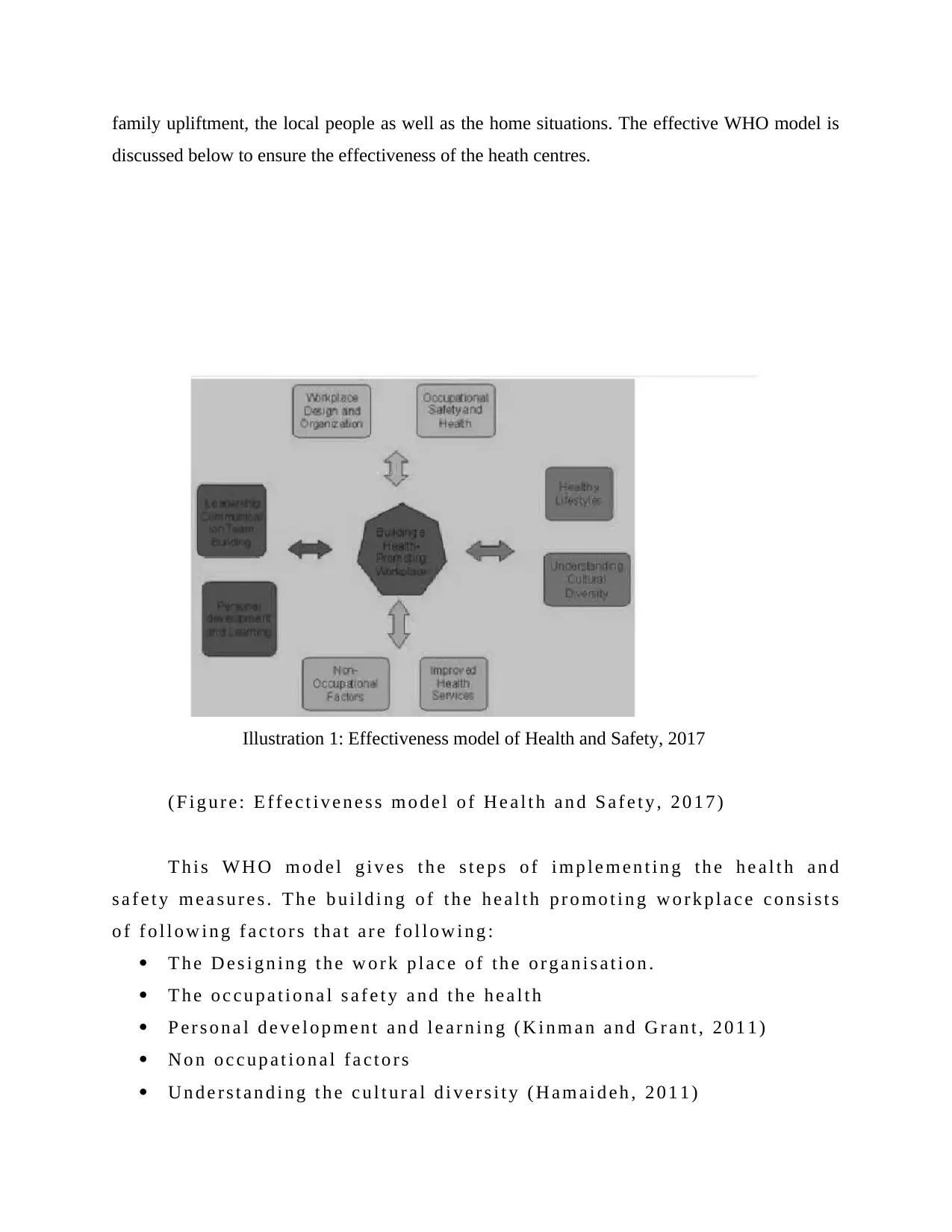
family upliftment, the local people as well as the home situations. The effective WHO model is
discussed below to ensure the effectiveness of the heath centres.
( F i g u r e : E f f e c t i v e n e s s m o d e l o f H e a l t h a n d S a f e t y , 2 0 1 7 )
T h i s W H O m o d e l g i v e s t h e s t e p s o f i m p l e m e n t i n g t h e h e a l t h a n d
s a f e t y m e a s u r e s . T h e b u i l d i n g o f t h e h e a l t h p r o m o t i n g w o r k p l a c e c o n s i s t s
o f f o l l o w i n g f a c t o r s t h a t a r e f o l l o w i n g :
T h e D e s i g n i n g t h e w o r k p l a c e o f t h e o r g a n i s a t i o n .
T h e o c c u p a t i o n a l s a f e t y a n d t h e h e a l t h
P e r s o n a l d e v e l o p m e n t a n d l e a r n i n g ( K i n m a n a n d G r a n t , 2 0 1 1 )
N o n o c c u p a t i o n a l f a c t o r s
U n d e r s t a n d i n g t h e c u l t u r a l d i v e r s i t y ( H a m a i d e h , 2 0 1 1 )
Illustration 1: Effectiveness model of Health and Safety, 2017
discussed below to ensure the effectiveness of the heath centres.
( F i g u r e : E f f e c t i v e n e s s m o d e l o f H e a l t h a n d S a f e t y , 2 0 1 7 )
T h i s W H O m o d e l g i v e s t h e s t e p s o f i m p l e m e n t i n g t h e h e a l t h a n d
s a f e t y m e a s u r e s . T h e b u i l d i n g o f t h e h e a l t h p r o m o t i n g w o r k p l a c e c o n s i s t s
o f f o l l o w i n g f a c t o r s t h a t a r e f o l l o w i n g :
T h e D e s i g n i n g t h e w o r k p l a c e o f t h e o r g a n i s a t i o n .
T h e o c c u p a t i o n a l s a f e t y a n d t h e h e a l t h
P e r s o n a l d e v e l o p m e n t a n d l e a r n i n g ( K i n m a n a n d G r a n t , 2 0 1 1 )
N o n o c c u p a t i o n a l f a c t o r s
U n d e r s t a n d i n g t h e c u l t u r a l d i v e r s i t y ( H a m a i d e h , 2 0 1 1 )
Illustration 1: Effectiveness model of Health and Safety, 2017
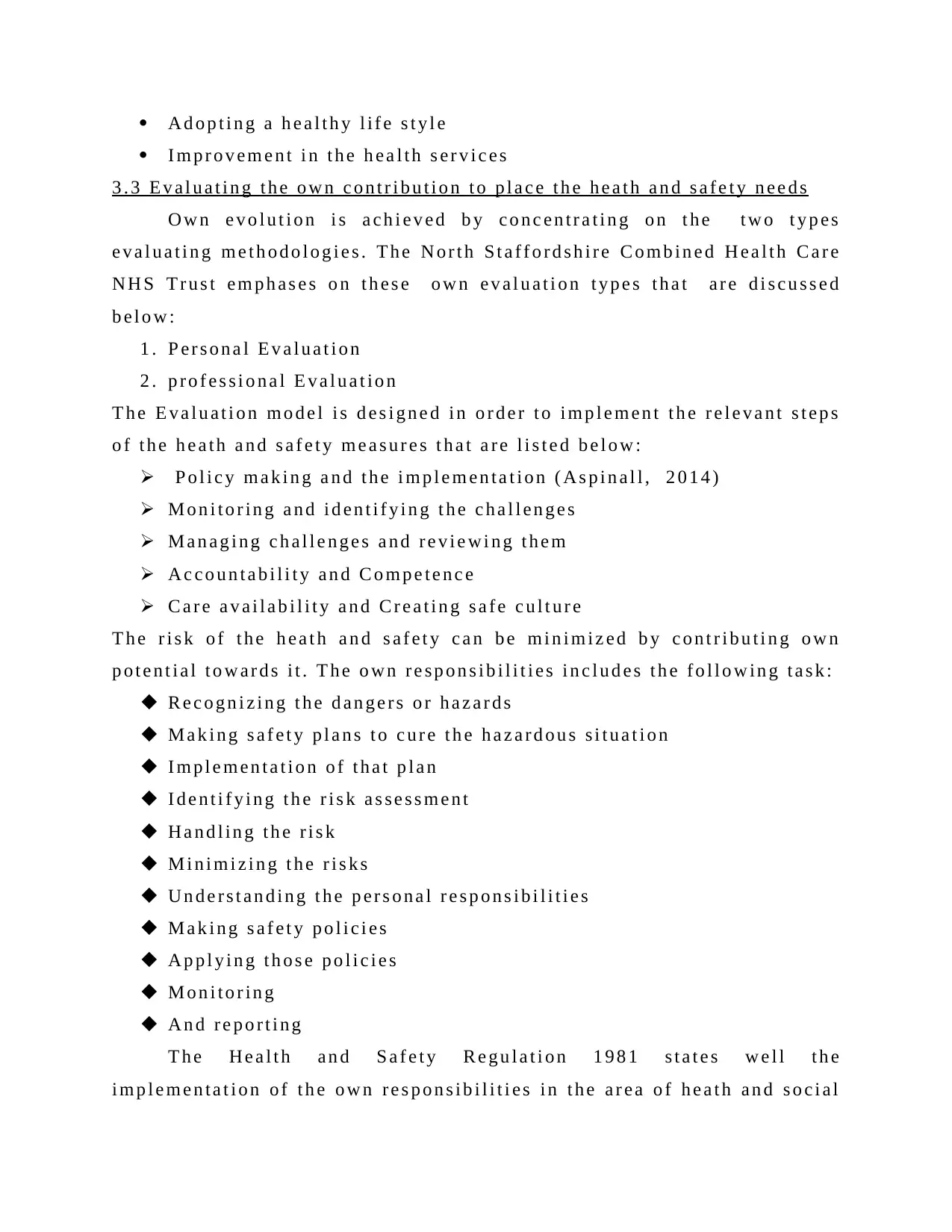
A d o p t i n g a h e a l t h y l i f e s t y l e
I m p r o v e m e n t i n t h e h e a l t h s e r v i c e s
3 . 3 E v a l u a t i n g t h e o w n c o n t r i b u t i o n t o p l a c e t h e h e a t h a n d s a f e t y n e e d s
O w n e v o l u t i o n i s a c h i e v e d b y c o n c e n t r a t i n g o n t h e t w o t y p e s
e v a l u a t i n g m e t h o d o l o g i e s . T h e N o r t h S t a f f o r d s h i r e C o m b i n e d H e a l t h C a r e
N H S T r u s t e m p h a s e s o n t h e s e o w n e v a l u a t i o n t y p e s t h a t a r e d i s c u s s e d
b e l o w :
1 . P e r s o n a l E v a l u a t i o n
2 . p r o f e s s i o n a l E v a l u a t i o n
T h e E v a l u a t i o n m o d e l i s d e s i g n e d i n o r d e r t o i m p l e m e n t t h e r e l e v a n t s t e p s
o f t h e h e a t h a n d s a f e t y m e a s u r e s t h a t a r e l i s t e d b e l o w :
P o l i c y m a k i n g a n d t h e i m p l e m e n t a t i o n ( A s p i n a l l , 2 0 1 4 )
M o n i t o r i n g a n d i d e n t i f y i n g t h e c h a l l e n g e s
M a n a g i n g c h a l l e n g e s a n d r e v i e w i n g t h e m
A c c o u n t a b i l i t y a n d C o m p e t e n c e
C a r e a v a i l a b i l i t y a n d C r e a t i n g s a f e c u l t u r e
T h e r i s k o f t h e h e a t h a n d s a f e t y c a n b e m i n i m i z e d b y c o n t r i b u t i n g o w n
p o t e n t i a l t o w a r d s i t . T h e o w n r e s p o n s i b i l i t i e s i n c l u d e s t h e f o l l o w i n g t a s k :
R e c o g n i z i n g t h e d a n g e r s o r h a z a r d s
M a k i n g s a f e t y p l a n s t o c u r e t h e h a z a r d o u s s i t u a t i o n
I m p l e m e n t a t i o n o f t h a t p l a n
I d e n t i f y i n g t h e r i s k a s s e s s m e n t
H a n d l i n g t h e r i s k
M i n i m i z i n g t h e r i s k s
U n d e r s t a n d i n g t h e p e r s o n a l r e s p o n s i b i l i t i e s
M a k i n g s a f e t y p o l i c i e s
A p p l y i n g t h o s e p o l i c i e s
M o n i t o r i n g
A n d r e p o r t i n g
T h e H e a l t h a n d S a f e t y R e g u l a t i o n 1 9 8 1 s t a t e s w e l l t h e
i m p l e m e n t a t i o n o f t h e o w n r e s p o n s i b i l i t i e s i n t h e a r e a o f h e a t h a n d s o c i a l
I m p r o v e m e n t i n t h e h e a l t h s e r v i c e s
3 . 3 E v a l u a t i n g t h e o w n c o n t r i b u t i o n t o p l a c e t h e h e a t h a n d s a f e t y n e e d s
O w n e v o l u t i o n i s a c h i e v e d b y c o n c e n t r a t i n g o n t h e t w o t y p e s
e v a l u a t i n g m e t h o d o l o g i e s . T h e N o r t h S t a f f o r d s h i r e C o m b i n e d H e a l t h C a r e
N H S T r u s t e m p h a s e s o n t h e s e o w n e v a l u a t i o n t y p e s t h a t a r e d i s c u s s e d
b e l o w :
1 . P e r s o n a l E v a l u a t i o n
2 . p r o f e s s i o n a l E v a l u a t i o n
T h e E v a l u a t i o n m o d e l i s d e s i g n e d i n o r d e r t o i m p l e m e n t t h e r e l e v a n t s t e p s
o f t h e h e a t h a n d s a f e t y m e a s u r e s t h a t a r e l i s t e d b e l o w :
P o l i c y m a k i n g a n d t h e i m p l e m e n t a t i o n ( A s p i n a l l , 2 0 1 4 )
M o n i t o r i n g a n d i d e n t i f y i n g t h e c h a l l e n g e s
M a n a g i n g c h a l l e n g e s a n d r e v i e w i n g t h e m
A c c o u n t a b i l i t y a n d C o m p e t e n c e
C a r e a v a i l a b i l i t y a n d C r e a t i n g s a f e c u l t u r e
T h e r i s k o f t h e h e a t h a n d s a f e t y c a n b e m i n i m i z e d b y c o n t r i b u t i n g o w n
p o t e n t i a l t o w a r d s i t . T h e o w n r e s p o n s i b i l i t i e s i n c l u d e s t h e f o l l o w i n g t a s k :
R e c o g n i z i n g t h e d a n g e r s o r h a z a r d s
M a k i n g s a f e t y p l a n s t o c u r e t h e h a z a r d o u s s i t u a t i o n
I m p l e m e n t a t i o n o f t h a t p l a n
I d e n t i f y i n g t h e r i s k a s s e s s m e n t
H a n d l i n g t h e r i s k
M i n i m i z i n g t h e r i s k s
U n d e r s t a n d i n g t h e p e r s o n a l r e s p o n s i b i l i t i e s
M a k i n g s a f e t y p o l i c i e s
A p p l y i n g t h o s e p o l i c i e s
M o n i t o r i n g
A n d r e p o r t i n g
T h e H e a l t h a n d S a f e t y R e g u l a t i o n 1 9 8 1 s t a t e s w e l l t h e
i m p l e m e n t a t i o n o f t h e o w n r e s p o n s i b i l i t i e s i n t h e a r e a o f h e a t h a n d s o c i a l
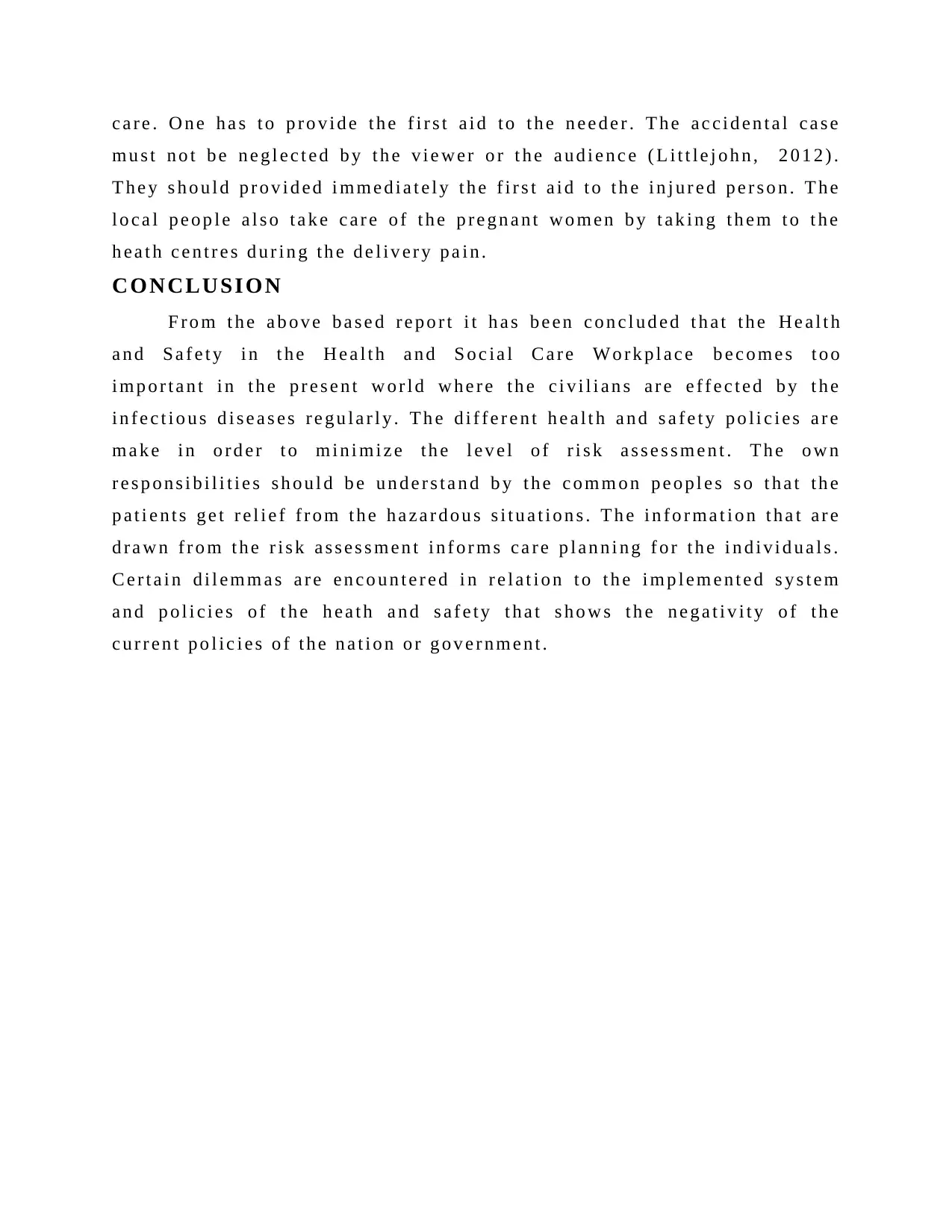
c a r e . O n e h a s t o p r o v i d e t h e f i r s t a i d t o t h e n e e d e r . T h e a c c i d e n t a l c a s e
m u s t n o t b e n e g l e c t e d b y t h e v i e w e r o r t h e a u d i e n c e ( L i t t l e j o h n , 2 0 1 2 ) .
T h e y s h o u l d p r o v i d e d i m m e d i a t e l y t h e f i r s t a i d t o t h e i n j u r e d p e r s o n . T h e
l o c a l p e o p l e a l s o t a k e c a r e o f t h e p r e g n a n t w o m e n b y t a k i n g t h e m t o t h e
h e a t h c e n t r e s d u r i n g t h e d e l i v e r y p a i n .
C O N C L U S I O N
F r o m t h e a b o v e b a s e d r e p o r t i t h a s b e e n c o n c l u d e d t h a t t h e H e a l t h
a n d S a f e t y i n t h e H e a l t h a n d S o c i a l C a r e W o r k p l a c e b e c o m e s t o o
i m p o r t a n t i n t h e p r e s e n t w o r l d w h e r e t h e c i v i l i a n s a r e e f f e c t e d b y t h e
i n f e c t i o u s d i s e a s e s r e g u l a r l y . T h e d i f f e r e n t h e a l t h a n d s a f e t y p o l i c i e s a r e
m a k e i n o r d e r t o m i n i m i z e t h e l e v e l o f r i s k a s s e s s m e n t . T h e o w n
r e s p o n s i b i l i t i e s s h o u l d b e u n d e r s t a n d b y t h e c o m m o n p e o p l e s s o t h a t t h e
p a t i e n t s g e t r e l i e f f r o m t h e h a z a r d o u s s i t u a t i o n s . T h e i n f o r m a t i o n t h a t a r e
d r a w n f r o m t h e r i s k a s s e s s m e n t i n f o r m s c a r e p l a n n i n g f o r t h e i n d i v i d u a l s .
C e r t a i n d i l e m m a s a r e e n c o u n t e r e d i n r e l a t i o n t o t h e i m p l e m e n t e d s y s t e m
a n d p o l i c i e s o f t h e h e a t h a n d s a f e t y t h a t s h o w s t h e n e g a t i v i t y o f t h e
c u r r e n t p o l i c i e s o f t h e n a t i o n o r g o v e r n m e n t .
m u s t n o t b e n e g l e c t e d b y t h e v i e w e r o r t h e a u d i e n c e ( L i t t l e j o h n , 2 0 1 2 ) .
T h e y s h o u l d p r o v i d e d i m m e d i a t e l y t h e f i r s t a i d t o t h e i n j u r e d p e r s o n . T h e
l o c a l p e o p l e a l s o t a k e c a r e o f t h e p r e g n a n t w o m e n b y t a k i n g t h e m t o t h e
h e a t h c e n t r e s d u r i n g t h e d e l i v e r y p a i n .
C O N C L U S I O N
F r o m t h e a b o v e b a s e d r e p o r t i t h a s b e e n c o n c l u d e d t h a t t h e H e a l t h
a n d S a f e t y i n t h e H e a l t h a n d S o c i a l C a r e W o r k p l a c e b e c o m e s t o o
i m p o r t a n t i n t h e p r e s e n t w o r l d w h e r e t h e c i v i l i a n s a r e e f f e c t e d b y t h e
i n f e c t i o u s d i s e a s e s r e g u l a r l y . T h e d i f f e r e n t h e a l t h a n d s a f e t y p o l i c i e s a r e
m a k e i n o r d e r t o m i n i m i z e t h e l e v e l o f r i s k a s s e s s m e n t . T h e o w n
r e s p o n s i b i l i t i e s s h o u l d b e u n d e r s t a n d b y t h e c o m m o n p e o p l e s s o t h a t t h e
p a t i e n t s g e t r e l i e f f r o m t h e h a z a r d o u s s i t u a t i o n s . T h e i n f o r m a t i o n t h a t a r e
d r a w n f r o m t h e r i s k a s s e s s m e n t i n f o r m s c a r e p l a n n i n g f o r t h e i n d i v i d u a l s .
C e r t a i n d i l e m m a s a r e e n c o u n t e r e d i n r e l a t i o n t o t h e i m p l e m e n t e d s y s t e m
a n d p o l i c i e s o f t h e h e a t h a n d s a f e t y t h a t s h o w s t h e n e g a t i v i t y o f t h e
c u r r e n t p o l i c i e s o f t h e n a t i o n o r g o v e r n m e n t .
Secure Best Marks with AI Grader
Need help grading? Try our AI Grader for instant feedback on your assignments.
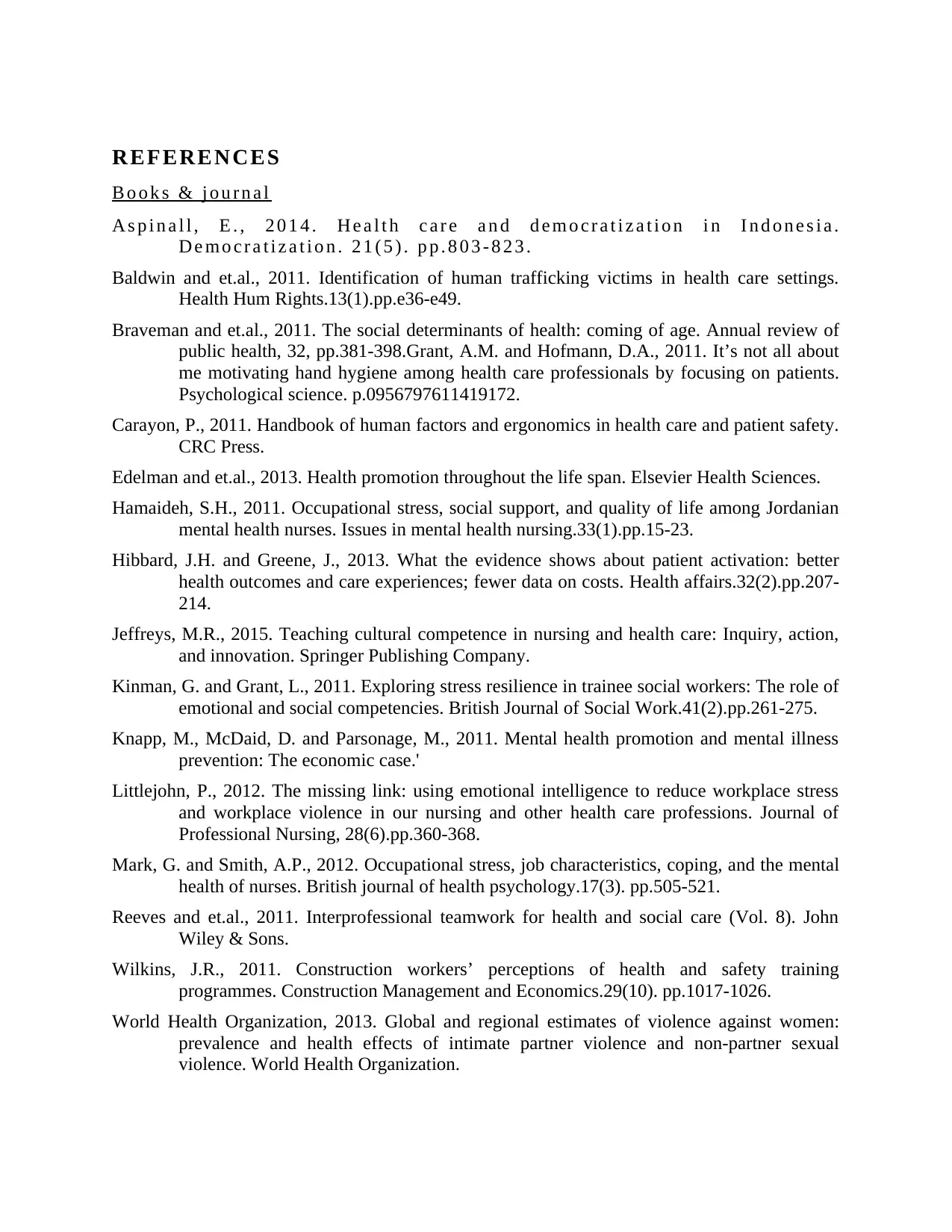
R E F E R E N C E S
B o o k s & j o u r n a l
A s p i n a l l , E . , 2 0 1 4 . H e a l t h c a r e a n d d e m o c r a t i z a t i o n i n I n d o n e s i a .
D e m o c r a t i z a t i o n . 2 1 ( 5 ) . p p . 8 0 3 - 8 2 3 .
Baldwin and et.al., 2011. Identification of human trafficking victims in health care settings.
Health Hum Rights.13(1).pp.e36-e49.
Braveman and et.al., 2011. The social determinants of health: coming of age. Annual review of
public health, 32, pp.381-398.Grant, A.M. and Hofmann, D.A., 2011. It’s not all about
me motivating hand hygiene among health care professionals by focusing on patients.
Psychological science. p.0956797611419172.
Carayon, P., 2011. Handbook of human factors and ergonomics in health care and patient safety.
CRC Press.
Edelman and et.al., 2013. Health promotion throughout the life span. Elsevier Health Sciences.
Hamaideh, S.H., 2011. Occupational stress, social support, and quality of life among Jordanian
mental health nurses. Issues in mental health nursing.33(1).pp.15-23.
Hibbard, J.H. and Greene, J., 2013. What the evidence shows about patient activation: better
health outcomes and care experiences; fewer data on costs. Health affairs.32(2).pp.207-
214.
Jeffreys, M.R., 2015. Teaching cultural competence in nursing and health care: Inquiry, action,
and innovation. Springer Publishing Company.
Kinman, G. and Grant, L., 2011. Exploring stress resilience in trainee social workers: The role of
emotional and social competencies. British Journal of Social Work.41(2).pp.261-275.
Knapp, M., McDaid, D. and Parsonage, M., 2011. Mental health promotion and mental illness
prevention: The economic case.'
Littlejohn, P., 2012. The missing link: using emotional intelligence to reduce workplace stress
and workplace violence in our nursing and other health care professions. Journal of
Professional Nursing, 28(6).pp.360-368.
Mark, G. and Smith, A.P., 2012. Occupational stress, job characteristics, coping, and the mental
health of nurses. British journal of health psychology.17(3). pp.505-521.
Reeves and et.al., 2011. Interprofessional teamwork for health and social care (Vol. 8). John
Wiley & Sons.
Wilkins, J.R., 2011. Construction workers’ perceptions of health and safety training
programmes. Construction Management and Economics.29(10). pp.1017-1026.
World Health Organization, 2013. Global and regional estimates of violence against women:
prevalence and health effects of intimate partner violence and non-partner sexual
violence. World Health Organization.
B o o k s & j o u r n a l
A s p i n a l l , E . , 2 0 1 4 . H e a l t h c a r e a n d d e m o c r a t i z a t i o n i n I n d o n e s i a .
D e m o c r a t i z a t i o n . 2 1 ( 5 ) . p p . 8 0 3 - 8 2 3 .
Baldwin and et.al., 2011. Identification of human trafficking victims in health care settings.
Health Hum Rights.13(1).pp.e36-e49.
Braveman and et.al., 2011. The social determinants of health: coming of age. Annual review of
public health, 32, pp.381-398.Grant, A.M. and Hofmann, D.A., 2011. It’s not all about
me motivating hand hygiene among health care professionals by focusing on patients.
Psychological science. p.0956797611419172.
Carayon, P., 2011. Handbook of human factors and ergonomics in health care and patient safety.
CRC Press.
Edelman and et.al., 2013. Health promotion throughout the life span. Elsevier Health Sciences.
Hamaideh, S.H., 2011. Occupational stress, social support, and quality of life among Jordanian
mental health nurses. Issues in mental health nursing.33(1).pp.15-23.
Hibbard, J.H. and Greene, J., 2013. What the evidence shows about patient activation: better
health outcomes and care experiences; fewer data on costs. Health affairs.32(2).pp.207-
214.
Jeffreys, M.R., 2015. Teaching cultural competence in nursing and health care: Inquiry, action,
and innovation. Springer Publishing Company.
Kinman, G. and Grant, L., 2011. Exploring stress resilience in trainee social workers: The role of
emotional and social competencies. British Journal of Social Work.41(2).pp.261-275.
Knapp, M., McDaid, D. and Parsonage, M., 2011. Mental health promotion and mental illness
prevention: The economic case.'
Littlejohn, P., 2012. The missing link: using emotional intelligence to reduce workplace stress
and workplace violence in our nursing and other health care professions. Journal of
Professional Nursing, 28(6).pp.360-368.
Mark, G. and Smith, A.P., 2012. Occupational stress, job characteristics, coping, and the mental
health of nurses. British journal of health psychology.17(3). pp.505-521.
Reeves and et.al., 2011. Interprofessional teamwork for health and social care (Vol. 8). John
Wiley & Sons.
Wilkins, J.R., 2011. Construction workers’ perceptions of health and safety training
programmes. Construction Management and Economics.29(10). pp.1017-1026.
World Health Organization, 2013. Global and regional estimates of violence against women:
prevalence and health effects of intimate partner violence and non-partner sexual
violence. World Health Organization.
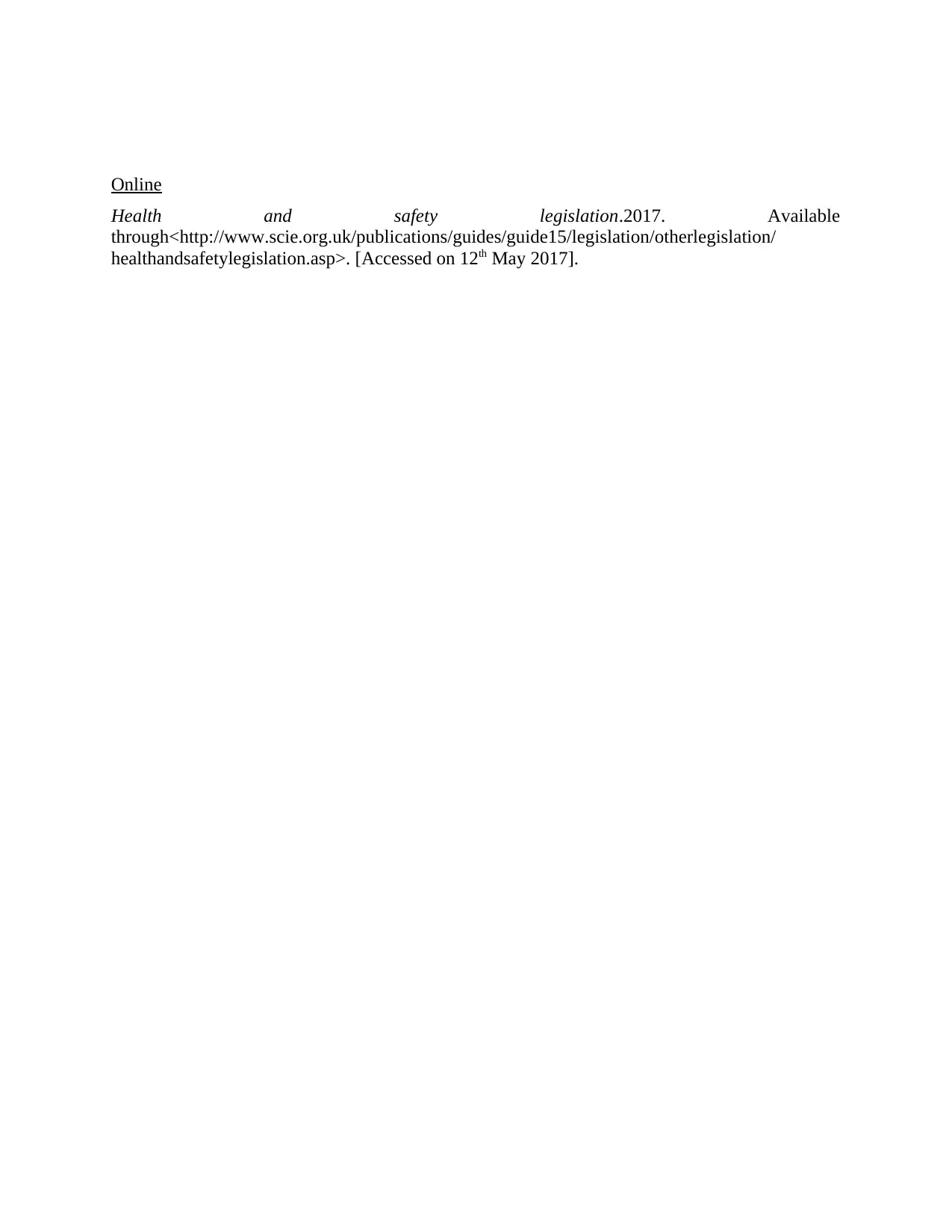
Online
Health and safety legislation.2017. Available
through<http://www.scie.org.uk/publications/guides/guide15/legislation/otherlegislation/
healthandsafetylegislation.asp>. [Accessed on 12th May 2017].
Health and safety legislation.2017. Available
through<http://www.scie.org.uk/publications/guides/guide15/legislation/otherlegislation/
healthandsafetylegislation.asp>. [Accessed on 12th May 2017].
1 out of 12
Related Documents
Your All-in-One AI-Powered Toolkit for Academic Success.
+13062052269
info@desklib.com
Available 24*7 on WhatsApp / Email
![[object Object]](/_next/static/media/star-bottom.7253800d.svg)
Unlock your academic potential
© 2024 | Zucol Services PVT LTD | All rights reserved.





